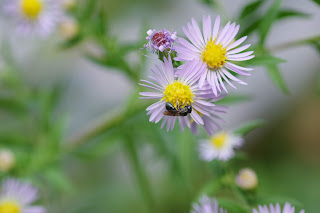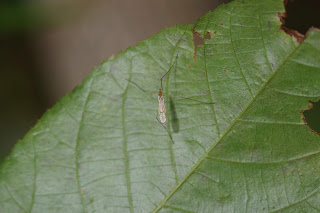There is a story behind my finding and photographing of today's Backyard Bug of the Day, but it is a long, boring story, so I won't tell it to you. I will only say this: today I found one of my bucket list-type bugs, and learned something fascinating about them. I didn't get any really satisfying pictures, so I am just going to post a bunch of them so maybe you will get a hint of how amazing it is, though when I explain what I learned about it you will perhaps get a better sense of it. Backyard Bug of the Day:
Golden tortoise beetle. I always enjoy finding tortoise beetles, but I have only ever found one species before, the clavate tortoise beetle, which is cool, but kind of plain. I have always wished to find a golden tortoise beetle because, well, look at this thing!
Here's the interesting thing, though–when I first spotted this, what I saw was a completely gold bug. Solid color, metallic, it looked like it could be made of real gold, except it was an insect. But then when I went to take its picture (here is where I am skipping the whole complicated story, but suffice to say things happened between me spotting the beetle, and taking photos of it), it had some gold glints, and a lot of iridescence (why do I have to look up the spelling of iridescence EVERY TIME I use it?), with what looks like an orange ladybeetle underneath. It was nothing like the all-gold bug I first spotted on a leaf as I worked in our new field, clearing invasive plants. I thought maybe it was the change in lighting, that maybe if it was in full sunshine again it would be all gold, but there was nothing I could do about that. Then when I looked it up in Insects of New England and New York (bt Tom Murray), I read this interesting fact: "Adults have the ability to change color from metallic gold to red when disturbed." Well, I had most certainly disturbed this beetle. And that was why it looked so different. Unfortunately, it did not reach a point where it felt undisturbed during the time I was able to see it (it eventually disappeared in the grass), so I don't have any pictures of it fully gold. But the book also says that morning glories are a food for it, so maybe it will find its way to the morning glory vines, and I'll spot it there and be able to photograph it without disturbing it.
Enjoy some more pictures of this amazing insect:
Other Bugs:
This is the time of year when male bumblebees leave the nest to try to mate, and they spend most of their time just eating. There are a LOT of them out there.
There were other pollinators, too. I may have seen a honeybee, but it might also have been a fly that looked like a honeybee. There were other flower flies:
There were a number of small pollinators, but they mostly moved so fast I could not see what they were. This one is a sweat bee, which I think most of them probably were.
This may also be a male sent out into the world to eat until winter takes it.
Here's one that was missing from yesterday's caterpillar round-up: white hickory tussock moth caterpillar. I saw a banded t.m.c., too, but I was unable to get a picture of it.
Also missing yesterday–fall webworm
The infested woolly bear is in the same spot, but it changed orientation today.
I didn't see any grasshoppers the last couple of days, but there were a few around today.
Green stinkbugs:
Crane fly. It appears to be missing a couple of legs.
Brown hooded owlet moth caterpillars
It's hard to tell from the pictures, but this one is quite a bit smaller than the other one.
It took me quite a while to figure out if this was the back end of a moth, or the front end of a hopper. The smaller one above is the exuvia of a hopper.
Front end of a hopper.
That I got this picture in today's windy conditions is a complete miracle.
This big moth on the side of the house looks like an American dagger moth, but dark brown instead of gray. I was not able to find an identification for it.
Later on it had moved a few inches away... (more on this in a moment...)
I found a nice variety of spiders for Arachnid Appreciation:
.
.
.
.
.
.
.
.
.
.
.
... I wonder if the jumping spider had anything to do with why the moth moved.
Grass spider, I think.
Jumping spider:
Marbled orb weaver. I haven't seen one of these in years.












































No comments:
Post a Comment